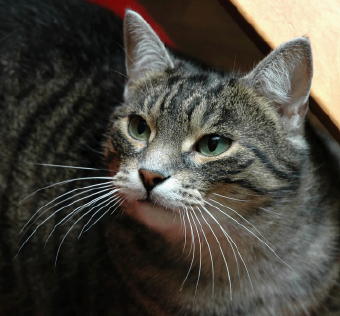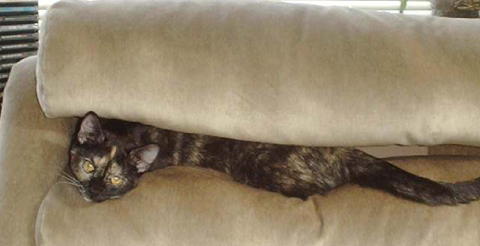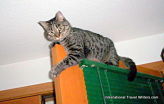Amazing performance of Cat Whiskers

Cat Health.. Cat whiskers (vibrissae) are so fundamental that a kitten in the womb grows its whiskers before any other hair. When born its whiskers are fully functional while its eyes and ears are not.
Whiskers occur in many species of animals, but the feline variety is special. Some whiskers extend out twice the width of their face. These hairs help cats survive as nocturnal hunters when light is low and eyesight is limited. These whiskers are acutely sensitive.
If a cat whisker moves only 5 nanometers (a distance 2000 times less than the width of a human hair) its sensory nerve sends a signal to the brain. Cats actually have whisker tufts in six locations: one extends from the back of each front leg; others extend from the eyebrows, lips, cheeks, and chin. These facial whiskers form radar that can detect even air movement.
Cat whiskers are also mobile. They can angle their chin and lip whiskers forward when greeting an owner or another cat, but move the whiskers back, out of the way, when fighting or feeding. Also, the top and bottom rows of lip hairs can move separately so that while the higher two rows point forward to warn of an upcoming obstacle, the lower two rows could be pointing down to keep tabs on a captured mouse.
The superciliary tuft above each eye and two genal tufts on each cheek help cats avoid eye injuries when exploring. With the help of carpal whisker tufts behind the wrists, the cat can feel its prey and detect any escape attempts. They also use their whiskers to decide whether they can fit in a small space.
Feline whiskers drop out periodically and this is normal shedding so there is no cat health issue. They drop out at different times so that the two weeks it takes to grow the replacement (in the same root area) leaves them enough hairs to still be able to monitor their world. However, cats can lose hairs for other reasons. My sibling calicoes get along fine, most of the time. But when they were young Blaze “barbered” her sister Revlon’s cat whiskers.
The vet guessed that it was a “feel safe” action to keep Revlon from straying too far away. Revlon and Blaze had been abandoned beside a dumpster at about 4 weeks old and although Blaze is the larger of the two, Revlon has protected her sister and made her feel safe. Blaze feared being left alone and “barbered” the whiskers to make Revlon feel unsafe exploring by herself. Mother cats will do that to kittens attempting to confine them.
Fortunately, because cats shed and regrow whiskers anyway, the “barbered” whiskers are only a temporary situation. Once Blaze felt safer and loved, the barbering of sister Revlon ended.
Cat whiskers are white with the exception of black cats with all black whiskers and Burmese with brown whiskers. A few nonconformists have a mixed set of both black and white hairs. Beneath the skin the follicles extend about three times deeper than ordinary hair follicles…sometimes reaching all the way to underlying muscle.
A blood-filled capsule (sinus) embroidered with a network of sensory nerves surround the whisker root. The blood in the sinus acts similar to hydraulic fluid, and any movement in the whisker is accentuated. Cats have very good night vision but cannot see in absolute darkness. Cats use their whiskers to navigate in such darkness.
A younger L'Oreal Blaze hiding in a recliner cushion (photo below)

Related Articles......
Return from Cat Whiskers to Cat Health Homepage
Having trouble finding what you need? Cat Health Index & Site Map
OR
Do you have a question to ask?...Questions
OR
Do you have a cat story to share?...Simply click here to go to that page!
Copyright@2010-2020 All rights reserved.Cat-health-detective.com
This website is information only. Consult a veterinarian for medical assistance

"Like Us" on Facebook
or...
"Like Us" here




















